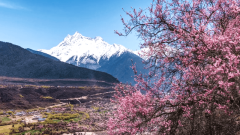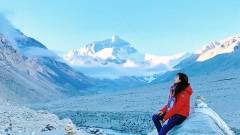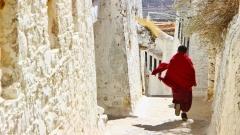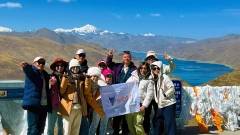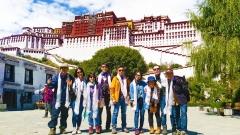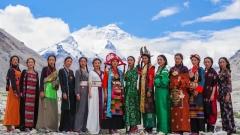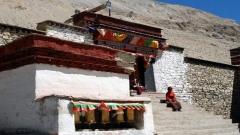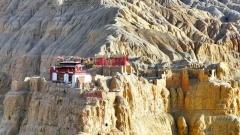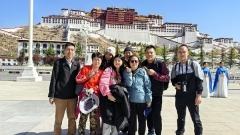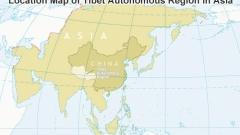For foreigners planning a trip to this remote plateau requires careful preparation and the right choice of travel style. This comprehensive, SEO‑friendly guide covers everything from tour options and transportation modes to sample itineraries, optimal trip lengths, permit requirements, and how China Dragon Travel can make your journey seamless and unforgettable.
Choosing Your Travel Style: Group Tour vs. Self‑Organized Small Group
When foreign visitors decide to explore Tibet, there are two main pathways: joining a packaged group tour arranged by a local Chinese agency, or organizing a private small group – often called a “customized tour” or “mini private tour.” Each has its own benefits and drawbacks.
1. Packaged Group Tours
Most foreign visitors opt to join a Tibet group tour offered by a licensed Chinese travel agency.
Advantages
- High Flexibility: You travel with like‑minded foreigners but still enjoy some free time at major attractions.
- Cost‑Effectiveness: Choosing a package that excludes entrance fees and meals gives you even greater freedom and lowers costs further.
- No Need to Organize Participants: Solo travelers or small parties can join without the hassle of recruiting friends.
Disadvantages
- Self‑Arranged Entry to China: You must book your own international flight or train to mainland China (most tours begin in Lhasa).
- Time Investment in Tour Selection: You’ll spend extra time comparing itineraries and departure dates to find the best fit.
2. Customized Small Groups
If you prefer total control and privacy, you can gather friends or family to form your own mini‑group, then hire a travel agency to handle logistics and permits.
Advantages
- Fully Tailored Itinerary: From daily schedules to lodging choices, every detail can be customized.
- Familiar Companions: Traveling only with people you know ensures a relaxed, barrier‑free experience.
Disadvantages
- Higher Per Person Cost: Smaller groups lose economies of scale, making packages pricier per traveler.
- Difficulty Assembling a Group: Rallying enough friends or relatives for a Tibet trip can be challenging, especially internationally.
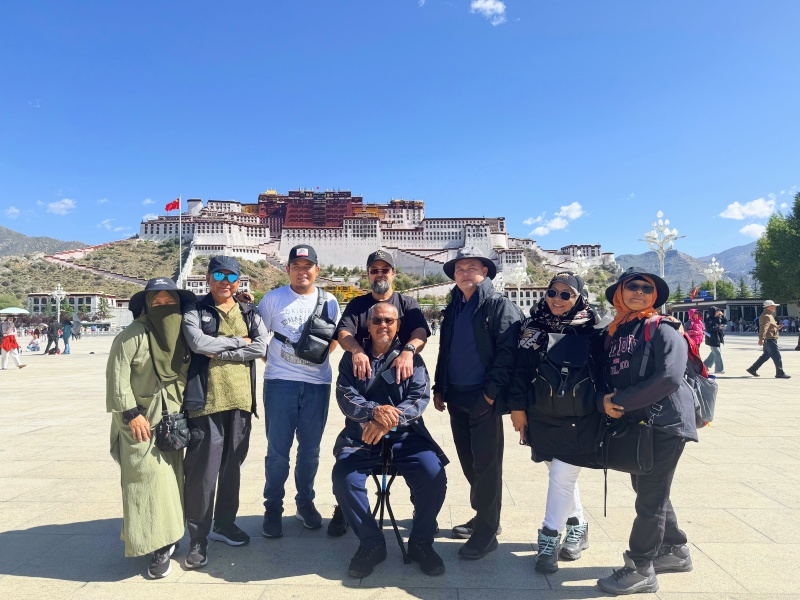
Transportation Modes for Foreigners
Foreign visitors entering Tibet must arrive by airplane or the Qinghai–Tibet Railway. Overland routes via road are generally reserved for mainland Chinese, Hong Kong, Macau and Taiwanese travelers holding mainland travel documents, and require extra coordination. Below is an analysis of each option.
1. By Airplane
- Major Airports: Lhasa Gonggar (LXA) is the principal gateway; a smaller number of flights serve Nyingchi (LZY).
- Typical Routes: Chengdu–Lhasa (approx. 2.5 hours), Beijing–Lhasa, Shanghai–Lhasa, Xi’an–Lhasa and regional options.
Pros
- Speed & Convenience: A direct flight from Chengdu to Lhasa takes just about 2.5 hours, minimizing altitude exposure.
- Reduced Altitude Sickness: Rapid ascent can actually lessen prolonged hypoxia, provided you rest on arrival.
Cons
- Higher Cost: Flights to Lhasa can be expensive, especially during peak season (May–October).
- Limited Availability: Seats fill up quickly; booking 2–3 months in advance is recommended.
2. By Qinghai–Tibet Railway
- Main Lines: Xining–Lhasa or Chengdu–Lhasa (via Xining or Lanzhou).
- Scenic Highlights: Tanggula Pass, Kunlun Mountains, Qinghai Lake, and remote grasslands.
Pros
- Unforgettable Scenic Journey: The world’s highest railway offers panoramic vistas of desolate plateaus and snow‑capped peaks.
- Cultural Immersion: You’ll share the carriage with both Tibetan and Han passengers, gaining glimpses into local life.
Cons
- Long Duration: Journey times often exceed 20 hours, making it physically taxing.
- Ticket Scarcity: Hard sleepers (upper bunks) are most coveted; reservation at least 1–2 months in advance is crucial.
- Limited Comfort: Sleeper compartments can be cramped; altitude cabin pressure may cause discomfort.
3. Overland by Road (For Mainland, HK/Macau & Taiwan with Mainland Docs Only)
While foreign visitors technically must enter Tibet by air or rail, mainland Chinese, Hong Kong/Macau residents and Taiwanese (with Mainland Travel Permits) may continue overland via:
- Chartered Vehicles: Private cars or minibuses.
- Self‑Drive: For drivers holding a C1+ Chinese license.
- Long‑Distance Buses: Scheduled coach services.
- Extreme Options: Cycling or even multi‑day trekking.
Pros
- Gradual Altitude Gain: Road travel allows bodies to adjust more naturally, reducing severe altitude sickness.
- Off‑the‑Beaten‑Path Views: Remote gorges, nomadic camps and seldom‑visited villages.
Cons
- Extended Travel Time: Road trips from Chengdu to Lhasa can take 2–3 days of driving.
- Restricted to Document Types: Foreign passports alone do not permit overland entry without the Tibet Travel Permit and sometimes additional local approvals.
Ideal Tibet Trip Days: 8–15 Days
Tibet’s vastness and high altitude demand thoughtful trip durations. Generally, 8–15 days strikes the optimal balance between acclimatization, sightseeing and immersion.
1. 8‑Day Essential Tour
Who It’s For: First‑timers focused on Lhasa and Everest Base Camp highlights.
- Days 1–2: Arrive in Lhasa; rest, light walking around Barkhor Street and Sera Monastery.
- Days 3–4: Full‑day tours of Potala Palace, Jokhang Temple and Norbulingka. Evening Tibetan opera or cultural show.
- Days 5–6: Drive via Yamdrok Lake and Karola Glacier to Shigatse; visit Tashilhunpo Monastery.
- Days 7–8: Proceed to Everest Base Camp; return to Lhasa via Nak Chu. Fly or train out.
2. 10–15‑Day Deep‑Dive into Ngari (Ali) Region
Who It’s For: Pilgrims and adventure seekers eager to circle Mount Kailash and visit Mansarovar.
- Days 1–4: Standard Lhasa circuit plus Shigatse & Everest Base Camp.
- Days 5–10: Long drive across the Changtang plateau into western Ngari; days of kora (circumambulation) around Everest‑like peaks and holy lakes.
- Days 11–15: Mount Kailash kora (3‑day trek), Mansarovar lake rituals, return to Lhasa or onward to Kathmandu.
3. Combined 5–6‑Day Lhasa + Linzhi Mini Tour
- Days 1–3: Lhasa highlights.
- Days 4–5: Transfer to Linzhi for forested valleys and waterfalls.
- Day 6: Return. Ideal for busy schedules or travelers seeking both cultural and natural attractions.
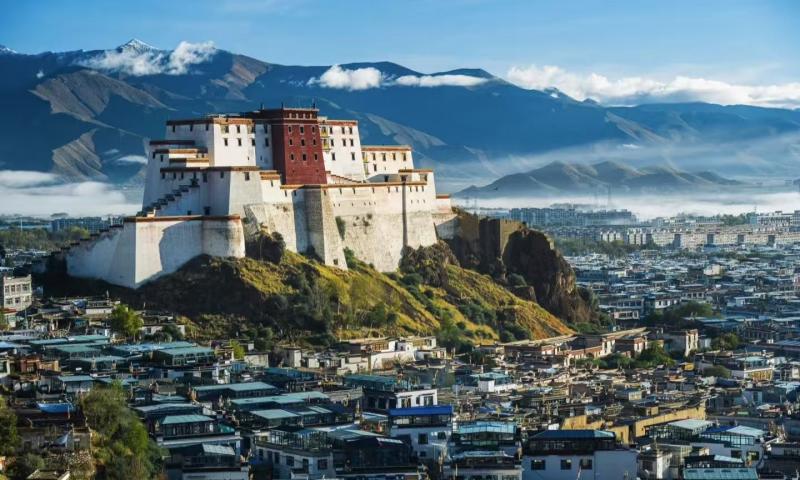
Three Signature Tibet Itineraries
Itinerary A: 8‑Day Lhasa & Everest Express ($ 965 USD/Pax)
Highlights: Potala Palace, Jokhang Temple, Barkhor Street, Yamdrok Lake, Karola Glacier, Tashilhunpo, Everest Base Camp, Nakchu Grasslands.
Itinerary:
- Arrive Lhasa – Hada ceremony – oxygen‑enhanced hotel
- Lhasa old town tour – Potala Palace – Jokhang Temple
- Barkhor Street free exploration – Sera Monastery debate
- Drive to Yamdrok Lake & Karola Glacier – overnight in Gyantse
- Gyantse to Shigatse – Tashilhunpo Monastery
- Shigatse to Everest Base Camp – sunrise over the world’s highest peak
- Return via Nakchu – Nakchu grasslands
- Back to Lhasa – departure
Itinerary B: 11‑Day Lhasa → Linzhi → Everest → Namtso (From $ 1243 USD/Pax)
Highlights: Adds the lush valleys of Linzhi and sacred Namtso Lake.
Itinerary:
1–3. Lhasa cultural immersion
4–5. Scenic drive to Linzhi: Niyang River Canyon & Ta’erdun Grand Canyon
6. Linzhi to Yamdrok Lake – return to Lhasa
7. Lhasa to Shigatse to Everest
8. Everest sunrise – back to Shigatse
9. Shigatse to Namtso Lake – lakeside camp
10. Namtso to Lhasa – final shopping at Barkhor
11. Departure
Itinerary C: 15‑Day Ngari Pilgrimage & Kailash Kora (From $ 1930 USD/Pax)
Highlights: Full circuit of Mount Kailash, Mansarovar, Selin Co, deep western Tibet.
Itinerary:
1–3. Lhasa classics including Potala, Jokhang, Norbulingka
4–5. Drive to Shigatse & Everest Base Camp
6–7. Journey across Changtang – remote nomad camps
8–10. Mount Kailash kora (three‑day trek)
11. Mansarovar sunrise rituals
12–13. Towards Guge Kingdom ruins & Tsaparang
14. Return drive via Dolma Pass – scenic high passes
15. Final return to Lhasa and departure
Permit Requirements for Tibet Itinerary
Tibet Travel Permit Essentials
- What It Is: Official document required for any foreign passport holder to enter the Tibet Autonomous Region.
- How to Apply: Foreign travelers cannot apply on their own—they must submit passport information and itinerary to a licensed local agency.
- Processing Time: Typically 7–10 business days after submission of documents.
Why Foreigners Choose China Dragon Travel
- Proven Expertise
- Over 15 years specializing in Tibet tours for international guests.
- Hassle‑Free Permits
- Free Tibet Travel Permit service—no hidden fees.
- Local Networks
- Partnerships with top‑rated hotels, guides and transport providers across Tibet.
- Customized Freedom
- Private departures, off‑season adventures and photography tours at your pace.
- Safety First
- Oxygen‑equipped vehicles, high‑altitude medical kits and 24/7 emergency support.
- Cultural Respect
- Guides trained in Tibetan etiquette, ensuring meaningful and responsible travel.
Tibet is not just a destination – it’s a transformative journey through dramatic landscapes and ancient spiritual traditions. As you plan your trip as a foreign visitor, remember that the right travel style, transportation mode, trip length and permit arrangements will set the stage for an unforgettable experience. With China Dragon Travel by your side, you gain full freedom to explore, coupled with professional support that guarantees comfort, safety and authenticity.
Ready to ascend to the Roof of the World? Contact China Dragon Travel today for your personalized Tibet itinerary, complete with free permit processing and expert guidance every step of the way.



